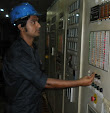Thermistors
The term thermistor is a contraction of the words thermal and resistor. The name is usually applied to metal-oxide sensors fabricated in the form of droplets, bars, cylinders, rectangular flakes, and thick films. A thermistor belongs to the class of absolute-temperature sensors; that is, it can measure temperature that is referenced to an absolute-temperature scale.
 |
| Thermistor |
All thermistors are divided into two groups: NTC (negative temperature coefficient) and PTC (positive temperature coefficient). Only the NTC thermistors are useful for precision temperature measurements.
NTC Thermistor
The NTC thermistors which are discussed herein are composed of metal oxides. The most commonly used oxides are those of manganese, nickel, cobalt, iron, copper and titanium. The fabrication of commercial NTC thermistors uses basic ceramics technology and continues today much as it has for decades. In the basic process, a mixture of two or more metal oxide powders are combined with suitable binders, are formed to a desired geometry, dried, and sintered at an elevated temperature. By varying the types of oxides used, their relative proportions, the sintering atmosphere, and the sintering temperature, a wide range of resistivities and temperature coefficient characteristics can be obtained.
READ DETAILS ABOUT NTC THERMISTOR
PTC Thermistor
All metals may be called PTC materials, however, their temperature coefficients of resistivity (TCR) are quite low . An RTD as described earlier also has a small PTC. In contrast, ceramic PTC materials in a certain temperature range are characterized by a very large temperature dependence. The PTC thermistors are fab-ricated of polycrystalline ceramic substances, where the base compounds, usually barium titanate or solid solutions of barium and strontium titanate (highly resistive materials), are made semiconductive by the addition of dopants. Above the Curie temperature of a composite material, the ferroelectric properties change rapidly, re-sulting in a rise in resistance, often several orders of magnitude.









